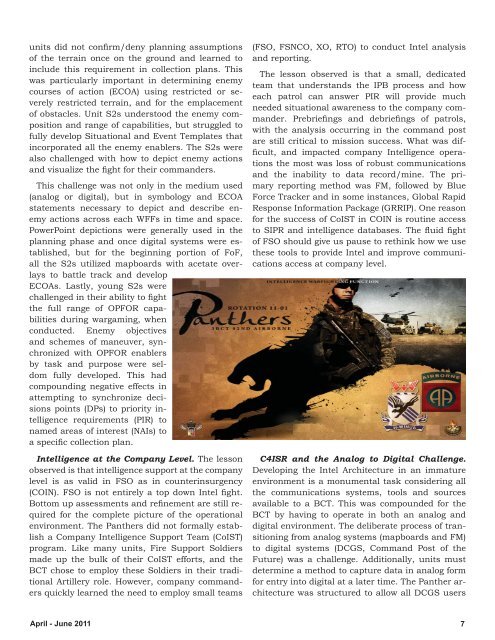George w. casey jr. - Federation of American Scientists
George w. casey jr. - Federation of American Scientists
George w. casey jr. - Federation of American Scientists
You also want an ePaper? Increase the reach of your titles
YUMPU automatically turns print PDFs into web optimized ePapers that Google loves.
units did not confirm/deny planning assumptions<br />
<strong>of</strong> the terrain once on the ground and learned to<br />
include this requirement in collection plans. This<br />
was particularly important in determining enemy<br />
courses <strong>of</strong> action (ECOA) using restricted or severely<br />
restricted terrain, and for the emplacement<br />
<strong>of</strong> obstacles. Unit S2s understood the enemy composition<br />
and range <strong>of</strong> capabilities, but struggled to<br />
fully develop Situational and Event Templates that<br />
incorporated all the enemy enablers. The S2s were<br />
also challenged with how to depict enemy actions<br />
and visualize the fight for their commanders.<br />
This challenge was not only in the medium used<br />
(analog or digital), but in symbology and ECOA<br />
statements necessary to depict and describe enemy<br />
actions across each WFFs in time and space.<br />
PowerPoint depictions were generally used in the<br />
planning phase and once digital systems were established,<br />
but for the beginning portion <strong>of</strong> FoF,<br />
all the S2s utilized mapboards with acetate overlays<br />
to battle track and develop<br />
ECOAs. Lastly, young S2s were<br />
challenged in their ability to fight<br />
the full range <strong>of</strong> OPFOR capabilities<br />
during wargaming, when<br />
conducted. Enemy objectives<br />
and schemes <strong>of</strong> maneuver, synchronized<br />
with OPFOR enablers<br />
by task and purpose were seldom<br />
fully developed. This had<br />
compounding negative effects in<br />
attempting to synchronize decisions<br />
points (DPs) to priority intelligence<br />
requirements (PIR) to<br />
named areas <strong>of</strong> interest (NAIs) to<br />
a specific collection plan.<br />
Intelligence at the Company Level. The lesson<br />
observed is that intelligence support at the company<br />
level is as valid in FSO as in counterinsurgency<br />
(COIN). FSO is not entirely a top down Intel fight.<br />
Bottom up assessments and refinement are still required<br />
for the complete picture <strong>of</strong> the operational<br />
environment. The Panthers did not formally establish<br />
a Company Intelligence Support Team (CoIST)<br />
program. Like many units, Fire Support Soldiers<br />
made up the bulk <strong>of</strong> their CoIST efforts, and the<br />
BCT chose to employ these Soldiers in their traditional<br />
Artillery role. However, company commanders<br />
quickly learned the need to employ small teams<br />
(FSO, FSNCO, XO, RTO) to conduct Intel analysis<br />
and reporting.<br />
The lesson observed is that a small, dedicated<br />
team that understands the IPB process and how<br />
each patrol can answer PIR will provide much<br />
needed situational awareness to the company commander.<br />
Prebriefings and debriefings <strong>of</strong> patrols,<br />
with the analysis occurring in the command post<br />
are still critical to mission success. What was difficult,<br />
and impacted company Intelligence operations<br />
the most was loss <strong>of</strong> robust communications<br />
and the inability to data record/mine. The primary<br />
reporting method was FM, followed by Blue<br />
Force Tracker and in some instances, Global Rapid<br />
Response Information Package (GRRIP). One reason<br />
for the success <strong>of</strong> CoIST in COIN is routine access<br />
to SIPR and intelligence databases. The fluid fight<br />
<strong>of</strong> FSO should give us pause to rethink how we use<br />
these tools to provide Intel and improve communications<br />
access at company level.<br />
C4ISR and the Analog to Digital Challenge.<br />
Developing the Intel Architecture in an immature<br />
environment is a monumental task considering all<br />
the communications systems, tools and sources<br />
available to a BCT. This was compounded for the<br />
BCT by having to operate in both an analog and<br />
digital environment. The deliberate process <strong>of</strong> transitioning<br />
from analog systems (mapboards and FM)<br />
to digital systems (DCGS, Command Post <strong>of</strong> the<br />
Future) was a challenge. Additionally, units must<br />
determine a method to capture data in analog form<br />
for entry into digital at a later time. The Panther architecture<br />
was structured to allow all DCGS users<br />
April - June 2011 7















